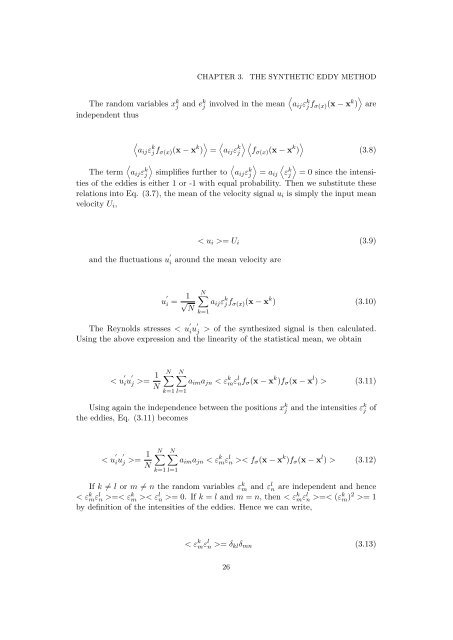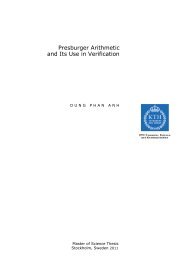Synthetic Inflow Condition for Large Eddy Simulation (Synthetic - KTH
Synthetic Inflow Condition for Large Eddy Simulation (Synthetic - KTH
Synthetic Inflow Condition for Large Eddy Simulation (Synthetic - KTH
Create successful ePaper yourself
Turn your PDF publications into a flip-book with our unique Google optimized e-Paper software.
The random variables x k j and ek j<br />
independent thus<br />
CHAPTER 3. THE SYNTHETIC EDDY METHOD<br />
involved in the mean<br />
�<br />
aijε k j fσ(x)(x − x k � �<br />
) = aijε k � �<br />
j fσ(x)(x − x k �<br />
)<br />
�<br />
aijεk j fσ(x)(x − xk �<br />
) are<br />
(3.8)<br />
�<br />
The term aijεk �<br />
�<br />
j simplifies further to aijεk � �<br />
j = aij εk �<br />
j = 0 since the intensities<br />
of the eddies is either 1 or -1 with equal probability. Then we substitute these<br />
relations into Eq. (3.7), the mean of the velocity signal ui is simply the input mean<br />
velocity Ui,<br />
< ui >= Ui<br />
and the fluctuations u ′<br />
i around the mean velocity are<br />
u ′<br />
i = 1<br />
√ N<br />
(3.9)<br />
N�<br />
aijε k j fσ(x)(x − x k ) (3.10)<br />
k=1<br />
The Reynolds stresses < u ′<br />
iu′ j > of the synthesized signal is then calculated.<br />
Using the above expression and the linearity of the statistical mean, we obtain<br />
< u ′<br />
iu ′<br />
j >= 1<br />
N<br />
N�<br />
k=1 l=1<br />
N�<br />
aimajn < ε k mε l nfσ(x − x k )fσ(x − x l ) > (3.11)<br />
Using again the independence between the positions x k j and the intensities εk j of<br />
the eddies, Eq. (3.11) becomes<br />
< u ′<br />
iu ′<br />
j >= 1<br />
N<br />
N�<br />
k=1 l=1<br />
N�<br />
aimajn < ε k mε l n >< fσ(x − x k )fσ(x − x l ) > (3.12)<br />
If k �= l or m �= n the random variables ε k m and ε l n are independent and hence<br />
< ε k mε l n >=< ε k m >< ε l n >= 0. If k = l and m = n, then < ε k mε l n >=< (ε k m) 2 >= 1<br />
by definition of the intensities of the eddies. Hence we can write,<br />
< ε k mε l n >= δklδmn<br />
26<br />
(3.13)

















